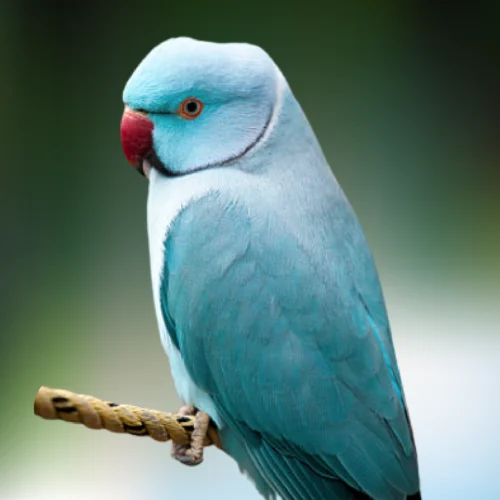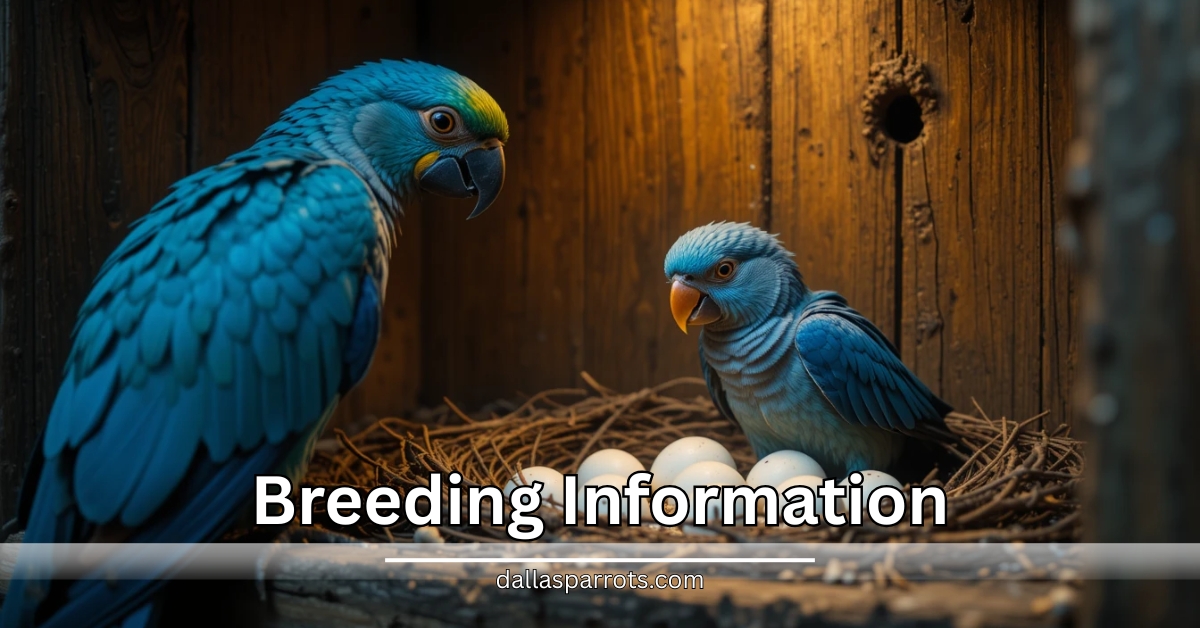

Blue Indian Ringneck Parrot Price, Lifespan, Complete Care and Guide
Blue Indian Ringneck Parrot is a striking, colorful bird known for its bright blue feathers and distinctive black ring around its neck. These playful, lively parrots are full of energy and curious by nature, making them unique companions for bird lovers.
Their charming personality shines through their ability to mimic sounds and words, creating a strong bond with their people. From my experience, their joyful and fun nature makes them a favorite pet, but they need a smooth transition into their new home to feel secure.
Get Our healthy Blue Indian Ringneck at Dallas Parrots
At Dallas Parrots, we specialize in breeding healthy, hand-raised Blue Indian Ringnecks with exceptional temperament and vibrant colors. Each parrot is vet-checked, DNA-tested, and comes with a health guarantee to ensure you bring home a happy, thriving companion.
Premium Blue Indian Ringneck Starter Kit
✔ High-quality pellet blend for optimal nutrition
✔ Natural wood perches & stimulating toys
✔ Calcium supplement & care guide
✔ Perfect for new owners
Pros and Cons of Ownership
| Pros | Cons |
| Smart & highly trainable excels at training and tricks | Needs daily interaction can become lonely if neglected |
| Playful personality loves games and puzzles | Requires consistent attention (2-4 hours/day) |
| Beautiful blue feathers striking appearance | Loud vocalizations (not ideal for apartments) |
| Strong bonding potential deeply affectionate with care | Can get stressed by routine changes |
| Social and friendly enjoys family lifestyles | Regular feather maintenance (dust, molting) |
| Adapts well to daily routines | Not a “low maintenance” pet demands time |
Blue Indian Ringneck Buying Guide
| Key Factor | What to Look For | Red Flags |
| Source | Reputable breeders (hand-raised, health checks) | Pet stores with crowded/dirty cages |
| Health Check | Bright eyes, smooth feathers, active behavior | Crusty nostrils, bald spots, lethargy |
| Age | Babies (8-16 weeks): Tame easier | Untamed adults with unknown history |
| Gender | Males: Talk more, develop neck rings | No DNA test for young birds |
| Questions to Ask | “Diet? Socialization? Vet checks?” | Seller avoids questions or paperwork |
| Setup Prep | Spacious cage (24″x24″x36″), toys, pellets | Unprepared environment |
Pro Tip: Always visit the bird in person before buying!
Lifespan and Health
With the right care, a healthy Blue Indian Ringneck Parrot can live for 25 to 30 years, so dedication is essential. Weekly medical checkups help in stopping infections and early problem identification. Their diet must include fresh fruits, veggies, and clean water—avoid fatty seeds to keep them happy and avoid feather plucking. A clean cage (sanitized weekly) reduces disease risks. I’ve noticed mine stays vibrant with daily interaction and a stress free environment neglect can shorten their lifespan.
Average lifespan in captivity
With good care, these vibrant birds make lifelong companions, typically living 25-30 years in captivity. A proper diet, clean environment, and regular attention help them thrive even longer .I’ve seen well cared for ringnecks reach their mid 30s! Their longevity means they’re not just pets, but decades long family members requiring dedicated care.
Common health issues to watch for
- Feather condition changes often plucking usually indicates stress or vitamin deficiencies
- Watch for respiratory difficulties; labored breathing typically signals infections or poor air quality
- Sudden behavior changes (like lethargy) may reveal hidden health problems
- Poor diet leads to serious deficiencies – address nutritional gaps immediately
- Early detection is crucial for all these conditions
Tips for ensuring a long, healthy life
- Diet is everything: Offer balanced meals of high quality pellets, fresh vegetables, and fruits skip seed only diets to avoid deficiencies
- Water matters: Change it twice daily and use filtered or quality drinking water
- Cage essentials: Provide enough space for movement and perches of different textures
- Cleaning routine: Disinfect the cage weekly to prevent bacterial growth
- Exercise daily: Allow supervised out of cage time for flying/climbing
- Early detection saves lives: Schedule annual vet checkups even for healthy birds
- Mental health counts: Rotate toys weekly to prevent boredom related stress
Diet and Nutrition
A proper diet is crucial for your Blue Indian Ringneck’s health. Start with a balanced base of high-quality pellets, which should make up 60-70% of their meals. Supplement this with daily fresh offerings like nutrient rich vegetables (kale, carrots) and fruits (apples, berries). While occasional treats like unsalted nuts can be great training rewards, remember to feed them in moderation.
Most importantly, avoid toxic foods like avocado and chocolate, which can be fatal to parrots. Don’t forget about their water change it twice daily and clean bowls with vinegar to keep bacteria at bay. With this nutritional approach, your feathered friend will thrive.
Recommended daily diet (pellets, fruits, vegetables)
For a balanced diet, high quality pellets should be the main food (60-70% of meals), providing essential vitamins and minerals. Supplement with fresh vegetables like carrots and spinach, along with fruits such as apples and berries for added nutrients. This mix ensures your parrot gets all the nutrition it needs to stay healthy and vibrant.
Foods to avoid
Avoid these risky and possibly dangerous items at all costs to keep your parrot safe: chocolate, avocado, caffeine, and alcohol. Also steer clear of salty or sugary snacks, as these can cause serious health issues. Even seemingly innocent human snacks often contain hidden dangers for birds. When in doubt, stick to bird safe foods only.
Importance of fresh water and occasional treats
Fresh water is essential for proper digestion and keeping your parrot hydrated—change it twice daily to ensure cleanliness. While seeds and nuts make great treats, offer them in moderation to prevent unhealthy weight gain. A few almonds or sunflower seeds as rewards won’t hurt, but overdoing it can lead to obesity. For a bird to be happy and healthy, balance is necessary!
Housing and Environment
Our Blue Indian Ringneck needs a roomy cage (minimum 24″x24″x36″) with multiple perches of varying textures to keep feet healthy. Place it in a safe, draft free area away from kitchen fumes or other harmful airborne toxins. Include toys to keep them mentally active, and maintain a clean environment with weekly disinfecting. Always ensure the enclosure is secure to prevent escapes or injuries.
Ideal cage size and setup
| Feature | Requirement | Purpose |
| Minimum Size | 24″ (W) x 24″ (D) x 36″ (H) | Allows bird to move freely, stretch wings, and play comfortably |
| Bar Spacing | ½ inch gaps | Prevents escape while ensuring safety |
| Structure | Sturdy construction with horizontal bars | Supports climbing and provides durability |
| Interior Setup | Multiple perches at varying heights, open space | Encourages natural behaviors and reduces stress |
| Material | Non toxic, powder coated metal | Ensures a safe, chew resistant environment |
Notes:
- Larger than minimum dimensions are encouraged for added comfort.
- Avoid round cages—corners provide security for roosting.
Placement of perches and toys
For a happy, healthy Blue Indian Ringneck, strategically place varied texture perches at different heights near food/water areas. Rotate stimulating toys like bells, ropes, and puzzle items weekly to prevent boredom and keep your bird mentally active. Include climbing nets for exercise while ensuring all items are safely sized to prevent injury. This setup promotes healthy feet, mental engagement, and natural behaviors.
Importance of a clean and safe environment
A clean cage is vital to prevent diseases—wash bowls daily and disinfect weekly using safe, bird-friendly cleaning products. Keep the cage away from kitchen fumes, smoke, and harsh chemicals, which can harm your parrot’s sensitive respiratory system. Ensure proper sunlight exposure (without overheating) and avoid drafts near windows. A toxin-free space keeps your bird healthy and happy!
Socialization and Training
Use soft, calm words and praise to build trust during bonding sessions. Reward desired behaviors with small treats and toys, reinforcing commands with patience. Address behavioral issues early with positive reinforcement—this approach keeps your parrot happy and eager to learn. Consistent, gentle care strengthens your connection while preventing future problems.
Tips for bonding with your parrot
- Start slow: Spend time near their cage, speaking softly to build trust
- Use treats strategically: Offer favorite snacks from your hand to create positive associations
- Prioritize comfort: Always ensure your parrot feels safe and loved during interactions
- Never force contact: Let them approach you at their own pace
- Be patient: Consistent, gentle efforts will make them seek your company willingly takes time.
Basic training techniques
- Start short: Keep training sessions brief (5 -10 minutes) to maintain focus
- Step up practice: Gently press your hand against their belly while saying “up”
- Reward good behavior: Immediately give treats and praise when they obey commands
- Stay positive: End on a high note to keep them eager for next time
How to handle behavioral issues
To manage behavioral issues like bites or screams, stay calm and avoid reinforcing negative behavior—redirect with toys or brief ignoring. Prevent boredom by rotating enrichment items and giving regular attention. Always use positive reward-based training, as punishment increases stress. Address root causes (like lack of stimulation) for lasting results.
Breeding Information
For successful breeding, provide a wooden nest box (resembling tree holes) in a quiet space during spring the ideal time for mating. Parents typically raise chicks for 2-3 years before they mature. Ensure proper care with extra nutrition and minimal disturbances. To copy natural spaces, use boxes with a small entrance hole (6 inches in diameter).
Breeding age and season
Blue Indian Ringnecks reach breeding maturity at 2-3 years old, with peak activity in spring when warmer temperatures trigger natural instincts. The season typically lasts several months, though pairs may bond for longer. Females lay eggs every 3 days during clutch production. For best results, simulate natural light cycles and provide extra nutrition during this period.
Nesting habits and care for chicks
Blue Indian Ringnecks prefer wooden nest boxes (12″x12″x24″) with a small entrance hole (2-3 inches) to mimic natural tree holes. During breeding, parents will feed chicks for 6-8 weeks after they hatch—never disturb the nest or force chicks to leave prematurely. Keep the environment warm (75-80°F) and quiet. Ensure nesting boxes are placed high in the cage for security.
Considerations before breeding
Breeding Blue Indian Ringnecks requires significant time, extra care, and financial readiness costs for vet visits, chicks’ needs, and proper setup add up quickly. Ensure you have adequate space (a separate quiet area) to keep breeding pairs and offspring safe. Assess if you can commit to the 2+ years of responsibility for each chick’s development before starting.
Price Breakdown
| Expense Category | Estimated Cost Range | Details |
| Food | $30–$60 | Quality pellets, fresh produce, treats |
| Toys | $20–$50 | Rotating enrichment items monthly |
| Cage Repairs | $0–$100 | Replace worn perches/parts (unexpected) |
| Vet Visits | $300–$600 | Annual checkups + emergencies |
Total Monthly Average: $60–$150
Unexpected Costs/Year: $400–$1,000+
Key Notes:
- Initial cage setup costs extra ($200–$800).
- Always budget for unexpected health emergencies.
Initial purchase price range
| Factor | Price Influence | Details |
| Breeder | $300–$600+ | Ethical breeders charge more for health guarantees |
| Color | +$100–$300 | Rare mutations (e.g., violet, albino) cost extra |
| Age | Chicks ($200–$400) vs. Adults ($400–$800) | Hand fed babies often pricier but tamer |
| Reputation | +$200–$500 | Top breeders with proven quality bloodlines |
Note: Always verify health certifications—low prices may signal poor quality care.
Unexpected costs to be prepared for
When budgeting for your Blue Indian Ringneck, always account for potential unexpected costs that may arise. Medical emergencies like sudden illnesses or injuries can cost $200-$600 for emergency vet visits, diagnostics, and treatments. Your cage may need unexpected repairs ($50-$200) for broken bars or worn components. It’s wise to set aside extra funds for these situations . I recommend maintaining at least a $500 emergency budget. Having this safety net ensures you can handle any costs without compromising your parrot’s care.
Physical Characteristics
The Blue Indian Ringneck Parrot is instantly recognizable by its bright cobalt blue feathers and the sleek black ring around its neck (found only in adult males). While slightly smaller, females share the same colorful, lively charm. These parrots have a warm, expressive presence with an elegant long tail that adds to their stunning appearance.
Their playful nature shines through in their curious movements, making them irresistible to people encountering them for the first time. Whether perched or in flight, their new owners are always captivated by that signature Ringneck elegance.
Distinctive blue coloration and features
The Indian Ringneck Parrot boasts a unique and beautiful color palette, with richer, deeper blues in males compared to the softer sky blue or light green hues seen in some variants. Their body is adorned with special feathers that create a striking contrast against the black ring around their neck a signature look that sets them apart from different parrot species. Whether in sunlight or shade, their blue plumage shimmers, making them one of the most unique and visually captivating Ringneck varieties.
Differences between males and females
While both genders share the colorful charm of Blue Indian Ringneck Parrots, several key features distinguish them:
| Feature | Male Parrots | Female Parrots |
| Neck Ring | Bold black ring (develops at 2-3 years) | No ring or very faint shadow |
| Size | Larger, more robust | Slightly smaller frame |
| Coloration | Richer, deeper blue tones | Less intense coloration |
| Rare Variants | Some show pink undertones | More pastel hues |
These beautiful Indian Ringneck birds make wonderful companions regardless of gender, though their physical traits help owners understand and appreciate their Parrots better.
Common behaviors and temperament
Blue Indian Ringneck Parrots are playful, curious, and highly intelligent birds with lively personalities. Their sharp minds make them excellent at mimicry with proper training and patience, they can learn words and sounds. While naturally cautious and sometimes shy around new surroundings, they form strong bonding connections with their people once comfortable.
These parrots love to explore and interact with toys, though their independent streak can present a fun challenge for owners. When socialized well, they transform from reserved to delightfully talkative companions.
Traits:
- Intelligent: Quick learners but need consistent training
- Social: Bonds deeply but may be initially cautious
- Active: Requires mental stimulation (toys/puzzles)
Benefits of having a Blue Indian Ringneck as a pet
- Great companions that form strong bonds with their owners
- Highly smart birds that can learn words and phrases (excellent talkers!)
- Playful nature provides endless entertainment and joy
- Their stunning blue color makes them beautiful additions to any home
- Generally friendly and social when properly socialized
- Intelligent nature allows for fun training interactions
- Bright personalities make them engaging lifelong pets
Challenges and responsibilities involved
Caring for these birds requires a genuine daily time commitment of about two to four hours to ensure their well-being and healthy development. They are naturally social creatures, and neglect can lead to loneliness or behavioral problems. A proper, balanced diet is essential—seeds alone aren’t enough, so some research and preparation are needed to meet their nutritional needs.
Regular, patient training helps manage common behaviors like loud calling or nipping. They also need a spacious cage and a safe area outside the cage for exercise. These birds are sensitive to changes in routine, and inconsistent care can lead to stress or even feather plucking.
Is this parrot the right fit for you?
While these parrots make wonderful pets capable of deep bonding, they’re not ideal for everyone. Their need for daily care and meaningful interaction (2-4 hours) means they’ll struggle in homes where owners are frequently away or too busy. Without adequate time and attention, these sensitive birds easily become lonely or stressed, leading to behavioral issues.
They thrive best with owners whose lifestyle allows for consistent routines and plenty of social engagement. If you can meet their needs, you’ll gain an incredibly rewarding companion but they demand commitment matching their 25+ year lifespan.
Real life experiences from Blue Indian Ringneck owners
Through consistent training and plenty of interaction, I’ve developed an incredibly close bond with my Blue Indian Ringneck. Their smart and playful nature brings endless joy they learn tricks quickly and love showing off! These parrots thrive when engaged daily, and the connection we’ve built is truly special.
Why Dallas Parrots Trusted platefrom for buy any parrot
Dallas Parrots is a trusted platform for anyone looking to buy a healthy, well-cared-for parrot. We focus on raising birds in a loving, social environment, with 2 to 4 hours of daily interaction to support their mental and emotional development. Our parrots are fed a carefully planned, balanced diet not just seeds and are trained consistently to minimize loud calls and nipping.
They are given plenty of space to move, play, and stay active, with both large cages and safe out-of-cage time. Because parrots are sensitive to routine, we maintain a stable, stress-free environment that reduces the risk of issues like feather plucking. When you choose Dallas Parrots, you’re choosing quality, care, and lifelong support.
Benefits of Buying from Dallas Parrots
- Stress-free transition to your home
- Socialized parrots with daily interaction
- Balanced, species-appropriate diet
- Trained to reduce unwanted behaviors
- Spacious and stimulating living environment
- Support before and after purchase
- Transparent health and care history
Conclusion
Owning a Blue Indian Ringneck Parrot is a rewarding experience, but these beautiful, intelligent pets have unique needs that require proper care and understanding. Before buying, learn about their specific diet, social interaction requirements, and ideal environment.
With attention and the right approach, you can ensure your parrot lives a happy, healthy life.These wonderful birds thrive when their physical and emotional needs are met commit to their care, and you’ll have a lifelong companion.
FAQ's
What parrot should I get?
If you’re new to parrots, a budgie or cockatiel is easy to care for and friendly.
Which parrot is most friendly?
Cockatiels and Green Cheek Conures are very friendly and love human company.
Is my parrot a boy or a girl?
In some parrots, like Indian Ringnecks, males have a neck ring. A vet can confirm with a test.
Which colour parrot is lucky?
Green parrots are often seen as lucky, especially in Indian and Feng Shui beliefs.





